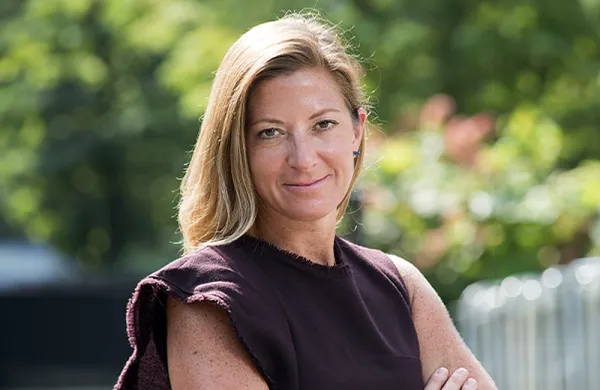In 2019, RWJ Barnabas Health (“RWJBH”), one of the largest health systems in the country and the second largest employer in New Jersey, offered a DC plan with an attractive investment line-up and high participant enrollment. But the organization’s executive team wanted to do more to ensure the retirement readiness of its 35,000 employees.
In an interview with their target date investment manager, Capital Group (“CG”), RWJBH’s CIO Eileen Urban (“EU”) discusses the healthcare system’s journey to build a solution that both engaged participants and instigated effective action.
The interview has been edited for length.
CG: Eileen, tell us about where you were in 2019 and the problem you faced.
EU: Following the merger of RWJ and Barnabas Health [in 2016], our combined organization had merged multiple legacy retirement plan designs and led a large-scale investment re-enrollment process. In early 2019, we turned our attention to employee engagement.We knew our existing communications weren’t resonating. It’s a situation many companies can appreciate. While all employers with DC plans offer a range of resources and tools to support employees as they plan for retirement, participants don’t always use or even recognize that these resources are available.
When Capital Group proposed designing an employee engagement program that would effectively reach and engage all employees, with special attention to diverse and under-served populations – while also coordinating closely with our recordkeeper Fidelity, and our investment consultant NEPC – we couldn’t say no.
CG: How did you plan to address this problem?
EU: We first wanted to better understand the needs of our employee population. Each of our 35,000 employees was assigned to one of 16 segments based on age, deferral or participation rate, overlaid with analysis on ethnicity and job type. Using our own analysis and parallel research from plans across the country, we identified three specific employee segments that would benefit most from a targeted communications program. We assigned them personas: the “Avoider” group, the “Late Bloomer” group and the “Motivated Saver” group.
The second part of our investigative process was qualitative. The team at Capital Group conducted face-to-face interviews with employees and their families to understand their thoughts on retirement, savings, finances, and what their aspirations and goals were. By holding these interviews where employees felt most comfortable – at home, in the cafeteria or at work – using open-ended questioning, a number of unexpected themes developed.
CG: What did you learn?
EU: The single most impactful learning had to do with timing. Barnabas employees work to specific timetables and in a unique environment. Many work shifts and responsibilities involve caring for patients. Not everyone is sitting at a computer for all or even part of a day. Also importantly, the language we use has to be accessible and easy to understand.Not surprisingly, employees were more receptive to messages about retirement planning if they were sent when they had time to read and digest them. It didn’t – and doesn’t – matter how helpful a communication is if it isn’t read!
Two additional themes also surfaced: trust and accessibility. RWJBH employees put enormous effort into their jobs. We often heard, ‘I give so much to my work and my patients. I expect the same level of care from you, my employer. I don’t want to spend hours on Google trying to figure out my retirement plans.’
CG: How did you apply these learnings?
EU: By combining what we’d learned about our employees’ working patterns and specific participant segments, we had the roadmap we needed to develop our program with Capital Group. Together, we launched MyRetirement in January 2020.The MyRetirement program includes an inviting, easy to use website along with an automated email nudging program. The entire program is tailored to the employee’s persona. The most important features are: one, the website and email journeys are completely white labeled for RWJBH, so that we could lean into the trust and the expectations employees have from us; and two, the website and emails easily connect to our recordkeeper, Fidelity. We talked early about the importance of accessibility. We knew going in that the experience for employees had to feel seamless and we had to make it incredibly easy to make changes on NetBenefits.
CG: How has the program been received?
EU: We have received a lot of positive feedback regarding the fun and interactive content. The retirement personality quiz for instance was a big hit. It’s a Buzzfeed-like quiz that aligns your retirement personality to an animal. Employees loved it and it created a lot of buzz. We even gave out MyRetirement socks with the animals and a QR code to the quiz.Another feature that our employees appreciated was the one-click to Fidelity. As mentioned, we knew early on that we had to guide employees through learning and taking action and we would have to make it easy. With our employees’ busy lifestyles, this one click feature keeps it simple for them.
CG: What results have you seen so far?
E.U. Since we launched the program, we’ve been so pleased to see high levels of employee engagement in all three segments and in terms of translating engagement to action. Participants who visited the site within its first 100 days increased their contribution at two times the rate as those who did not visit the site (14% vs. 7%). We also saw a 54% growth in the number of participants who increased their contribution compared to the same period last year. And with our under-50 “Avoider” group, we’ve seen increases in their contributions at three times the rate when engaged. We found these results staggering.From a DE&I perspective, we’re excited to see the meaningful impact across ethnic groups. Looking at Asian, Black, Hispanic, and White full time employees, all groups increase contribution rates at higher frequency once engaged with MyRetirement.
CG: What do you think is the next step in this journey?
EU: I think the pandemic has shone a bright light on the challenges many Americans face with regards to financial planning and preparedness. Across industries, companies are providing more financial wellness support, realizing there’s a demand for a more holistic approach to employee benefits.With this in mind, we’ve looked at the retirement timeline with its various phases – planning, transition, living in retirement – and we realized there’s more to be done in the transition phase. Questions about retirement and financial wellness don’t disappear when someone retires. In fact, a whole new set of questions appear, and I think there’s an opportunity for us to provide support during this phase.
Eileen Urban is Executive Vice President, Treasury, and Chief Investment Officer, RWJBarnabas Health.
For more information on how plan sponsors can support retirement readiness for all employees, please contact Vidhi Sanders, Capital Group’s head of Participant Engagement.
The experience described by RWJBarnabas Health may not be representative of the experience of other customers and is no guarantee of future performance or success. This content, developed by Capital Group, home of American Funds, should not be used as a primary basis for investment decisions and is not intended to serve as impartial investment or fiduciary advice. American Funds Distributors, Inc., member FINRA.






